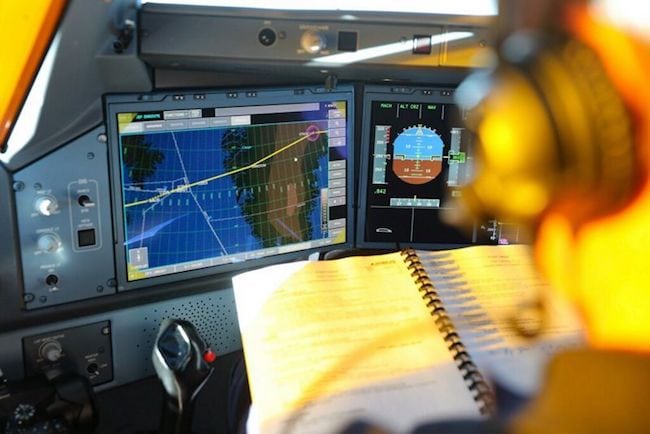
Airbus A350-1000 cockpit. Photo courtesy of Airbus
An avionics standards-making test equipment committee is currently hard at work, attempting to reinforce the role of test specifications within the overall process of testing and validating functionality and performance or airframe line replaceable units (LRU), and mechanical and electronic systems and components. ARINC Industry Activities’ subcommittee on avionics test equipment is attempting to do this by re-enforcing principles of an ARINC test equipment standard that has evolved with sophistication in avionics over the last two decades.
According to APIM 16-101, the test program set quality working group is currently working on an update to ARINC Report 625-3, to emphasize the importance that aviation OEMs provide a test specification that is “intelligible, unobscured, and complete as possible.” The group, whose chairman is Ted Patmore, avionics test engineer for Delta Air Lines, features engineers from Lufthansa Technik and Spherea, among others — all working toward the release of ARINC 625-4 in the near future.
“The target is to have two or three more meetings and submit the draft for approval at the next Avionics Maintenance Conference,” Patmore told Avionics. “After editing and making appropriate changes to the document, the resultant draft will be submitted to the AMC Steering Group for approval. The TPS working group members will meet three or four times to complete the update.”
During the recent 2017 AEEC/AMC annual general session, Patmore discussed the industry importance of the Technical Support Data Package (TSDP) concept, how it has evolved over time and why the move from ARINC 625-3 to ARINC 625-4 is necessary. First published in 1999, ARINC 625-1 introduced the TSDP concept, establishing an industry standard for providing avionics test specifications in “shop verified” plain English and the option for avionics test program sets to be provided in any computer language.
By the time ARINC 625-3 was published in 2012, TSDP had gone from serving only to give additional data outside of the main test specification document to become the primary document package requirement that includes the test specification. ARINC 625-3 also banned proprietary interfaces, tooling, protocol and data buses, as well as the use of test LRUs or a piece of aircraft, according to Patmore’s presentation. Some of the goals listed by Patmore in his presentation include helping to foster an open market for test solutions that are procurable over the life span of an airframe. He also notes that the role and quality of avionics test specifications needs to be reinforced and that test specification should not contain intellectual property.
Karsten Monteur, head of TTE engineering ERI and avionics for Lufthansa Technik AG, said that OEMs often deliver a TDSP that contains an “abundance of documents” that makes it difficult to ascertain the most relevant document test specification. Often TDSPs do not contain all of the necessary and relevant information to implement an alternative test solution to perform a return to service test on an aircraft, he said.
“Updating the existing ARINC Report 625-3 is necessary to emphasize the importance that an OEM provides a TS that is precise, easy to understand and complete. The updated ARINC Report 625 shall even be used by the OEM to define clear deliverables with his subcontractors since this is a frequent possibility of information loss,” Monteur told Avionics. “Furthermore it is essential that the TS is shop-verified.”
That would mean that the “OEM shall have implemented the TS at least once, for example as part of the design or production acceptance test,” said Monteur. This process step shall improve the ability of engineers to implement the test specification, while simultaneously reducing potential editorial mistakes within the spec, he said.
Next on the schedule for the TPS working group is a meeting in September when the group will continue to focus on progress toward ARINC 625-4, looking to clearly state the test specification requirements to be delivered on time, in a clear unobscured format and banishing the intellectual property concern.